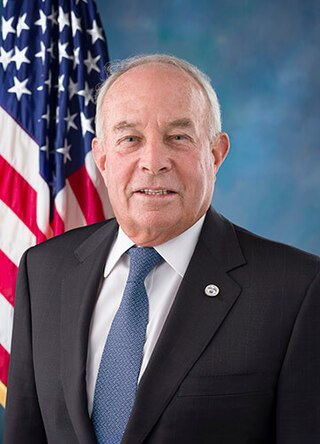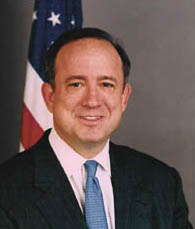Related Research Articles

A pension is a fund into which a sum of money is added during an employee's employment years and from which payments are drawn to support the person's retirement from work in the form of periodic payments. A pension may be a "defined benefit plan", where a fixed sum is paid regularly to a person, or a "defined contribution plan", under which a fixed sum is invested that then becomes available at retirement age. Pensions should not be confused with severance pay; the former is usually paid in regular amounts for life after retirement, while the latter is typically paid as a fixed amount after involuntary termination of employment before retirement.
A pension fund, also known as a superannuation fund in some countries, is any program, fund, or scheme which provides retirement income.

The Federal Deposit Insurance Corporation (FDIC) is a United States government corporation supplying deposit insurance to depositors in American commercial banks and savings banks. The FDIC was created by the Banking Act of 1933, enacted during the Great Depression to restore trust in the American banking system. More than one-third of banks failed in the years before the FDIC's creation, and bank runs were common. The insurance limit was initially US$2,500 per ownership category, and this has been increased several times over the years. Since the enactment of the Dodd–Frank Wall Street Reform and Consumer Protection Act in 2010, the FDIC insures deposits in member banks up to $250,000 per ownership category. FDIC insurance is backed by the full faith and credit of the government of the United States, and according to the FDIC, "since its start in 1933 no depositor has ever lost a penny of FDIC-insured funds".
In the United States government, independent agencies are agencies that exist outside the federal executive departments and the Executive Office of the President. In a narrower sense, the term refers only to those independent agencies that, while considered part of the executive branch, have regulatory or rulemaking authority and are insulated from presidential control, usually because the president's power to dismiss the agency head or a member is limited.

The savings and loan crisis of the 1980s and 1990s was the failure of 32% of savings and loan associations (S&Ls) in the United States from 1986 to 1995. An S&L or "thrift" is a financial institution that accepts savings deposits and makes mortgage, car and other personal loans to individual members.

The California Public Employees' Retirement System (CalPERS) is an agency in the California executive branch that "manages pension and health benefits for more than 1.5 million California public employees, retirees, and their families". In fiscal year 2020–21, CalPERS paid over $27.4 billion in retirement benefits, and over $9.74 billion in health benefits.

The Thrift Savings Plan (TSP) is a defined contribution plan for United States civil service employees and retirees as well as for members of the uniformed services. As of December 31, 2021, TSP has approximately 6.5 million participants, and more than $827.2 billion in assets under management; it is the largest defined contribution plan in the world. The TSP is administered by the Federal Retirement Thrift Investment Board, an independent agency.

The Federal Retirement Thrift Investment Board is an independent agency of the United States government by the Federal Employees Retirement System Act of 1986. It has roughly 270 employees. It was established to administer the Thrift Savings Plan, which is a retirement savings and investment plan for federal employees and members of the uniformed services, including the Ready Reserve. The Thrift Savings Plan is a tax-deferred defined contribution plan similar to a private sector 401(k) plan. The Thrift Savings Plan is one of the three parts of the Federal Employees Retirement System, and is the largest defined contribution plan in the world. As of August 2021, the board manages $794.7 billion in assets on behalf of 6.4 million participants. The board members and its chairman are nominated by the president and confirmed by the United States Senate.

The Central Provident Fund Board (CPFB), commonly known as the CPF Board or simply the Central Provident Fund (CPF), is a compulsory comprehensive savings and pension plan for working Singaporeans and permanent residents primarily to fund their retirement, healthcare, education and housing needs in Singapore.
The Civil Service Retirement System (CSRS) is a public pension fund organized in 1920 that has provided retirement, disability, and survivor benefits for most civilian employees in the United States federal government. Upon the creation of a new Federal Employees Retirement System (FERS) in 1987, those newly hired after that date cannot participate in CSRS. CSRS continues to provide retirement benefits to those eligible to receive them.
In Australia, superannuation or "super" is a retirement savings system. It involves money earned by an employee being placed into an investment fund, to be made legally available to fund members upon retirement.

A defined contribution (DC) plan is a type of retirement plan in which the employer, employee or both make contributions on a regular basis. Individual accounts are set up for participants and benefits are based on the amounts credited to these accounts plus any investment earnings on the money in the account. In defined contribution plans, future benefits fluctuate on the basis of investment earnings. The most common type of defined contribution plan is a savings and thrift plan. Under this type of plan, the employee contributes a predetermined portion of his or her earnings to an individual account, all or part of which is matched by the employer.

The Korea Deposit Insurance Corporation (KDIC) is a deposit insurance corporation, established in 1996 in South Korea to protect depositors and maintain the stability of the financial system. The main functions of KDIC are insurance management, risk surveillance, resolution, recovery, and investigation.
Dimensional Fund Advisors, L.P. is a private investment firm headquartered in Austin, Texas. Dimensional was founded in Chicago in 1981 by David Booth, Rex Sinquefield and Larry Klotz. The company has affiliates within 13 offices in the U.S., Canada, U.K., Germany, Netherlands, Australia, Singapore, and Japan. Dimensional maintains U.S. offices in Charlotte, North Carolina and Santa Monica, California and has affiliate offices globally. The company is owned by its employees, board members and outside investors.

Andrew Marshall Saul is an American businessman and political candidate who served as commissioner of the United States Social Security Administration from 2019 to 2021. Saul was fired from the position by President Joe Biden on July 9, 2021, after refusing to offer his requested resignation. Saul stated that his discharge was illegal.

Alberta Investment Management Corporation (AIMCo) is an Albertan Crown corporation and institutional investor established to manage several public funds and pensions headquartered in Edmonton, Alberta. AIMCo was established by an act of the Legislative Assembly of Alberta in 2008 under the government of Progressive Conservative Premier Ed Stelmach.

Benj. Franklin Savings and Loan was a thrift based in Portland, in the U.S. state of Oregon. Founded in 1925, the company was seized by the United States Government in 1990. In 1996 the United States Supreme Court found that this and similar seizures were based on an unconstitutional provision of the Financial Institutions Reform, Recovery, and Enforcement Act of 1989 (FIRREA). Shareholders of the thrift sued the federal government for damages caused by the seizure, with the shareholders winning several rounds in the courts. In 2013, $9.5 million was allocated for disbursement to shareholders.

Christopher Bancroft Burnham is and American business executive, public servant, and politician. He is the chairman and chief executive officer of Cambridge Global Capital, LLC and chairman of the board of EN+ Group. He has served as Under Secretary General for Management of the United Nations, Assistant Secretary of State for Resource Management and chief financial officer of the U.S. Department of State. He was a three-term Member of the Connecticut House of Representatives, Connecticut State Treasurer as well as vice chairman of Deutsche Bank Asset Management and global co-head of private equity.

myRA is a type of Roth IRA account sponsored by the United States Treasury and administered by Comerica. Richard Ludlow was the executive director of the program for the U.S. Treasury.

The Smart Savings Act made the default investment in the Thrift Savings Plan (TSP) an age-appropriate target date asset allocation investment fund instead of the Government Securities Investment Fund.
References
- ↑ "News Articles: Maximizing Your TSP Investments: When, Where and How Readers Check and Use Their Retirement Tools". Archived from the original on 2010-05-07. Retrieved 2010-01-20.
- 1 2 "Thrifty and Nifty (11/2/06) -- www.GovernmentExecutive.com". Archived from the original on 2008-09-05. Retrieved 2010-01-20.
- ↑ "Login". www.quantcast.com.
- ↑ "TSP finalizes rules on fund transfer restrictions (4/24/08) -- www.GovernmentExecutive.com". Archived from the original on 2009-10-24. Retrieved 2010-01-20.
- ↑ "The Official FRTIB Homepage". www.frtib.gov.